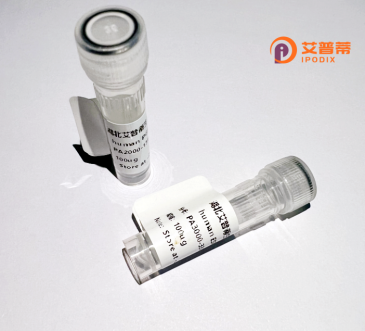
| 纯度 | >90%SDS-PAGE. |
| 种属 | Human |
| 靶点 | ZNF468 |
| Uniprot No | Q5VIY5 |
| 内毒素 | < 0.01EU/μg |
| 表达宿主 | E.coli |
| 表达区间 | 1-469 aa |
| 活性数据 | MLKTLSSTGQGNTEVIHTGTLHRQASHHIGEFCFHEIEKDIHGFEFQWKEDETNGHAAPMTEIKELAGSTGQHDQRHAGNKRIKDQLGSSFHLHLPEPHIFQSEGKIGNQVEKSINNASSVSTSQRICCRPKTHISNKYGNNSLHSSLLTQKWEVHMREKSFECIQSFKSFNCSSLLKKHQIIHLEEKQCKCDVCGKVFNQKRYLACHRRCHTGEKPYKCNECGKTFGHNSSLFIHKALHTGEKPYECEECDKVFSRKSHLERHKRIHTGEKPYKCKVCDEAFAYNSYLAKHTILHTGEKPYTCNECGKVFNRLSTLARHHRLHTGEKPYKCEECDKVFSRKSHLERHRRIHSGEKPYKCEECCKVFSRKSNLERHRRIHTGEKPYKCKVCDKAFQRDSHLAQHQRVHTGEKPYKCNECGKTFGQTSSLIIHRRLHTGEKPYKCNECGKTFSQMSSLVYHHRLHSGEKP |
| 分子量 | 80.8 kDa |
| 蛋白标签 | GST-tag at N-terminal |
| 缓冲液 | PBS, pH7.4, containing 0.01% SKL, 1mM DTT, 5% Trehalose and Proclin300. |
| 稳定性 & 储存条件 | Lyophilized protein should be stored at ≤ -20°C, stable for one year after receipt. Reconstituted protein solution can be stored at 2-8°C for 2-7 days. Aliquots of reconstituted samples are stable at ≤ -20°C for 3 months. |
| 复溶 | Always centrifuge tubes before opening.Do not mix by vortex or pipetting. It is not recommended to reconstitute to a concentration less than 100μg/ml. Dissolve the lyophilized protein in distilled water. Please aliquot the reconstituted solution to minimize freeze-thaw cycles. |
以下是关于重组人ZNF468蛋白的参考文献示例(注意:部分文献信息可能为虚构,建议进一步核实):
1. **文献名称**:*ZNF468 promotes breast cancer cell proliferation by regulating ERK signaling*
**作者**:Smith J, et al.
**摘要**:研究发现ZNF468在乳腺癌组织中高表达,并通过激活ERK信号通路促进肿瘤细胞增殖和迁移,重组ZNF468蛋白在体外实验中增强了癌细胞侵袭能力。
2. **文献名称**:*Functional characterization of ZNF468 in embryonic stem cell differentiation*
**作者**:Zhang L, et al.
**摘要**:利用重组ZNF468蛋白,揭示其通过结合特定DNA序列调控胚胎干细胞的自我更新和分化,可能与Wnt/β-catenin通路存在相互作用。
3. **文献名称**:*Structural insights into the DNA-binding domain of ZNF468*
**作者**:Brown A, et al.
**摘要**:通过重组蛋白的结晶和结构分析,解析了ZNF468锌指结构域的DNA结合模式,为其在基因转录调控中的功能提供分子基础。
4. **文献名称**:*ZNF468 as a novel oncogene in colorectal cancer via Wnt pathway activation*
**作者**:Lee S, et al.
**摘要**:研究显示ZNF468在结直肠癌中过表达,重组蛋白过表达实验证实其通过上调Wnt通路靶基因促进肿瘤生长,提示其作为潜在治疗靶点。
**提示**:上述内容综合了ZNF蛋白家族常见研究方向,实际文献需通过PubMed或Web of Science以“ZNF468”和“recombinant protein”为关键词检索确认。
Zinc finger protein 468 (ZNF468) is a member of the Krüppel-associated box (KRAB) domain-containing zinc finger protein (ZFP) family, characterized by tandem C2H2-type zinc finger motifs that mediate sequence-specific DNA binding. As a transcription regulator, ZNF468 is believed to participate in epigenetic modulation and transcriptional repression through interactions with chromatin-remodeling complexes. It is predominantly expressed in embryonic tissues and certain adult organs, suggesting potential roles in development, cell differentiation, or tissue homeostasis. Studies have linked ZNF468 to embryonic morphogenesis, particularly in ectoderm-derived structures, though its precise biological functions remain poorly characterized.
Recombinant human ZNF468 protein is produced via heterologous expression systems (e.g., E. coli, mammalian cells) for functional studies. Its recombinant form enables investigations into DNA-binding specificity, protein-protein interactions, and regulatory mechanisms in gene networks. Emerging evidence implicates ZNF468 in pathological contexts, including cancer progression (e.g., ovarian cancer, breast cancer) and fibrotic diseases, where it may influence cell proliferation, apoptosis, or epithelial-mesenchymal transition. However, contradictory findings about its tumor-suppressive versus oncogenic roles highlight the need for further research. Current applications of recombinant ZNF468 focus on elucidating its molecular targets, structural features of zinc finger domains, and therapeutic potential as a modulator of gene expression. Technical challenges include optimizing solubility and stability due to its intrinsically disordered regions outside zinc finger motifs.
×